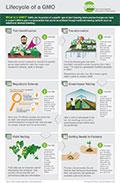Question
Answer
Expert response from Dr. Tim Durham
Farmer, Assistant Professor of Agronomy and Agricultural Sciences, Ferrum College
Monday, 07/05/2018 17:54
Dollars and sense! GMO development has historically been spearheaded by private industry. Without a doubt, it’s a grueling process – costly and time consuming. The R&D pipeline broadly includes:
- Discovery/market assessment
- Brainstorming ideas
- Are there any genes/traits that seem promising? Any identified market needs?
- Cost/benefit analysis
- How realistic are those ideas? Businesses are risk averse and need to justify new products to stakeholders
- Proof of concept/transformation
- Trait integration
- Take that GMO and use it as breeding stock to incorporate into an existing non-GMO variety that already has a superstar pedigree. Ironically, use conventional breeding to mass produce the GMO!
- Field trials
- How do the offspring perform under diverse in-field conditions?
- *Regulatory testing
- A gauntlet of testing to demonstrate substantial equivalence and familiarity – is the GMO chemically the same, and does it “behave” similarly in-field to a non-GMO equivalent?
- Intellectual property
- Secure intellectual property protection
- Pre-launch and commercialization
So after navigating all of these steps, how much is the final bill? Recent estimates put the tally at $136 million USD, and ~13 years from start to finish. And this just for one crop. The cost of doing business is onerous (many regulatory hurdles to jump) and exclusionary (only a few can afford to jump those hurdles out of the gate).
*Though it has no scientific basis, regulators assert that GMOs are unique enough to warrant special regulatory scrutiny. That narrows the field of competitors and makes GMO development less affordable.
How? The argument is that excessive regulation stifles smaller, more nimble entrants from the marketplace. This in turn perpetuates the idea that GMO development is concentrated in the hands of the few, squeezing out the little guy.
Although the mix of GMO crops is beginning to diversify in the marketplace (witness the Arctic Apple and Innate Potato), relatively few GMO crops have been available to date. With that said, "generation one" crops from 1996 onward usually have a significant market share. These include old standbys like corn, soybeans and cotton. These are high acreage and less risky – it’s easy to recoup R&D costs and turn a profit. Predictably, the private sector has focused on them, leaving niche/specialty crops to languish in purgatory. Compared to conventionally bred niche crops, the return on investment (ROI) for niche GMO’s doesn’t make economic sense!
In essence, a whole segment of the farming community is being ignored because companies balk at the costs of entry. My family operates a 30 acre vegetable farm in New York. We specialize in leafy greens (lettuce, spinach, kale, and the like). Our neighbors out East have GMO corn. We’d salivate over the prospect of GMO greens – if they existed.
Also consider the unintended consequences of overregulation on the most vulnerable. For example, non-profits working to develop “open source” biofortified Golden Rice and cassava in the developing world. No profit motivation – pure public good. Yet they’re subject to the same stringent regulations as corporations. Ironically, they’re being priced out of their own freebie markets.
So how do we make GMO development more affordable – and most importantly – accessible?
Land Grant Universities, the Agricultural Experiment Stations, the USDA-ARS, etc. are all performing cutting edge research using public dollars. In theory, they do the basic research that is then handed off to the private sector to be translated, applied, and decorate our dinner plates. This “finishing” is a vital component of public-private partnerships. Many promising (potential) GMO traits have been discovered, but the risks are too great, and rewards too low for a potential suitor in the private sector. There’s a disconnect between research aspirations in the public sector, and commercialization in the private sector.
That relationship needs to be realigned and clarified. These partnerships include public/private data sharing – a clearinghouse. For example, a public-private consortium was formed to sequence the rice genome in 2002. Information is available for all to use, without a paywall. That’s a strategy that spurs innovation and holds costs in line. Proprietary information artificially raises R&D costs.
Keeping with the data sharing theme, it’s also been suggested that a multinational database of GMO safety data be developed. This would be recognized between countries, satisfy regulatory requirements, and avoid needless duplication of effort, also keeping R&D costs down.
With that said, a general easing of GMO regulations would be the first logical step to ensure the long-term viability and affordability of GMO crop development – private or public, profit or non-profit.
